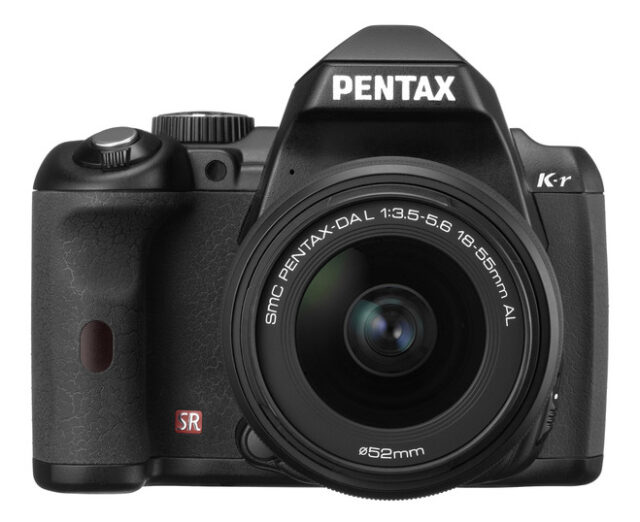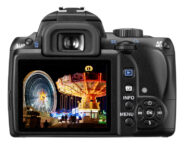Announced
Production status
System
Pentax K APS-C system cameras
- Pentax *ist D
- Pentax *ist DL
- Pentax *ist DL2
- Pentax *ist DS
- Pentax *ist DS2
- Pentax K-3
- Pentax K-3 II
- Pentax K-3 III
- Pentax K-3 III Monochrome
- Pentax K-30
- Pentax K-5
- Pentax K-5 II
- Pentax K-5 IIs
- Pentax K-50
- Pentax K-500
- Pentax K-7
- Pentax K-70
- Pentax K-m
- Pentax K-r
- Pentax K-S1
- Pentax K-S2
- Pentax K-x
- Pentax K100D
- Pentax K100D Super
- Pentax K10D
- Pentax K110D
- Pentax K200D
- Pentax K20D
- Pentax KF
- Pentax KP
Pentax K-r
APS-C AF digital SLR camera • Discontinued
Specification
| Format: | |
| APS-C | |
Imaging sensor: | 23.6 × 15.8mm CMOS sensor |
Resolution: | 4288 × 2848 - 12 MP |
Crop factor: | 1.52x |
Sensor-shift image stabilization: | Yes |
| Pentax K [45.5mm] | |
| Shutter: | |
Type: | Focal-plane |
Model: | Electronically controlled |
Speeds: | 30 - 1/6000 + B |
| Exposure: | |
Exposure metering: | Through-the-lens (TTL), open-aperture |
Exposure modes: | Programmed Auto |
| Aperture-priority Auto | |
| Shutter-priority Auto | |
| Manual | |
| Physical characteristics: | |
Weight: | 544g |
Dimensions: | 125x97x68mm |
Manufacturer description #1
September 9, 2010 - HOYA CORPORATION PENTAX Products is pleased to announce the launch of the PENTAX K-r lens-interchangeable digital SLR camera. Encased in a compact, lightweight body, this new model combines simple, user-friendly operation with a wide array of advanced features designed to enhance the fun and excitement of digital SLR photography.
Developed to be an entry model targeted at digital SLR novices and family users, the PENTAX K-r not only offers an assortment of features and functions that make it easy for everyone to effortlessly capture high-quality images people expect of a digital SLR camera, but it also comes equipped with a host of handy tools that help user in creating more personalized, creative images. They range from high-quality image reproduction with approximately 12.4 effective megapixels and HDTV-proportion movie recording, to high-speed continuous shooting at approximately six images per second, super-high-sensitivity shooting at ISO 25600 (via a custom function) and a large, easy-to-view 3.0-inch high-resolution color LCD monitor. Its dual-power-source design offers a choice between the standard rechargeable lithium-ion battery and a set of AA-size batteries.* It also offers a greater selection of digital filters for effortless production of original, creative artwork. All combined, the K-r boosts outstanding performance and versatility, almost the equivalent of upper-class digital SLR cameras, while allowing the photographer to easily deal with different photographic requirements and to accommodate individual shooting styles. It is also compatible with the IrSimple™ high-speed infrared data transmission system for wireless data transfer to IrSimple-compatible devices, and for swift image data exchange and match-game playing between two PENTAX K-r’s. Totally new capabilities in a digital SLR camera, these features make the K-r a unique, new-generation communications tool.
* Requires the optional AA Battery Holder D-BH109 to hold four AA-size batteries.
Major Features
1. High-quality, true-to-life image reproduction
The K-r incorporates a new-generation CMOS image sensor with approximately 12.4 effective megapixels to assure high-speed image data readout. It also features the high-performance PRIME (PENTAX Real Image Engine) II imaging engine to ensure accurate and high-speed data processing equal to that of upper-level models. As the result, the K-r produces high-quality images with fine detail, rich gradation and superb rendition, while suppressing annoying digital noise to a minimum. The K-r also offers a wide sensitivity range between ISO 200 and ISO 12800; this range can be expanded from ISO 100 to ISO 25600 via a custom function.
2. Compact, lightweight body
Despite the incorporation of the large 23.6mm x 15.8mm image sensor, the K-r sports a compact, lightweight body, thanks to a trim, lightweight stainless-steel chassis, a downsized in-body shake reduction mechanism, and state-of-the-art, high-density packaging technologies that assure space-efficient positioning and layout of the camera components.
3. High-speed continuous shooting at approximately six images per second
The K-r’s high-speed continuous shooting mode records as many as 25 images (in JPEG recording format) in a single sequence at a maximum speed of approximately six images per second — the fastest of all entry-class models — allowing the photographer to preserve sharp, crisp images of fast-moving subjects with great ease.
4. High-precision AF system
The K-r’s high-precision, wide-frame SAFOX IX autofocus system features 11 sensor points (with nine cross-type sensors positioned in the middle) to assure pinpoint focus on the subject. The K-r is also equipped with a spotbeam projector to assist the AF system in poorly lit locations. The accuracy and speed of contrast AF operation during Live View shooting has also been enhanced by the incorporation of a new-generation image sensor and drastic upgrading of AF algorithms.
5. Bright, clear optical viewfinder
Thanks to the combination of PENTAX-original finder optics and the renowned Natural-Bright-Matte focusing screen, the K-r’s viewfinder offers a bright, clear subject image at 0.85X magnification and with a 96% field of view. Since it assures excellent visibility even in bright outdoor locations and provides delay-free, real-time display of the subject’s image, it is especially helpful in shooting where the timing of shutter release is critical, such as sports photography. The in-focus point is indicated as a red point in the viewfinder for at-a-glance confirmation.
6. Large, easy-to-view 3.0-inch LCD monitor with wide-view design and approximately 921,000 dots
The K-r features a large, high-resolution color LCD monitor with approximately 921,000 dots. Its wide-view design assures a clear view of the monitor image from approximately 170 degrees horizontally and vertically, making it particularly useful in low- and high-angle applications during Live View shooting.
7. Versatile dual-power-source design
In addition to the standard rechargeable lithium-ion battery, which allows the photographer to capture approximately 560 images with a single recharge,** the K-r can also be powered by four AA-size batteries using optional AA Battery Holder D-BH109. Since these world-standard batteries are available almost anywhere, it removes worries about unexpected battery shortage, especially on the road.
** Based on the PENTAX in-house testing conditions conforming to the CIPA standards, using a rechargeable D-LI109 Lithium-Ion Battery.
8. PENTAX-original SR mechanism for sharp, blur-free images
The K-r features the PENTAX-developed SR (Shake Reduction) mechanism, which effectively compensates the adverse effect of camera shake by up to approximately four shutter steps. This innovative mechanism extends its benefits to almost all PENTAX interchangeable lenses — even those designed for film-format cameras.*** Thanks to this user-friendly mechanism, the K-r produces sharp, blur-free images even under demanding conditions prone to camera shake, such as when using a telephoto lens, shooting in the dark without flash illumination, and taking pictures of sunset scenes.
*** Lenses compatible with this mechanism: PENTAX K-, KA-, KAF-, KAF2- and KAF3-mount lenses; screw-mounted lenses (with an adapter); and 645- and 67-system lenses (with an adapter). Some functions may not be available with certain lenses.
9. Innovative image-processing functions to produce distinctive photographic expressions
i. Custom image function for distinctive finishing touches
The K-r features the custom image function, which allows the user to easily select a desired finishing touch for a particular image in order to more faithfully express his/her creative intention or emphasize the prevailing atmosphere. The K-r offers a choice of nine custom image modes including Bleach Bypass, which is designed to create a dramatic visual effect used in motion pictures.
ii. Versatile digital filter function
The K-r’s digital filter function allows the user to process recorded images in a variety of creative ways and produce highly creative visual expressions — without the need of a computer. The user not only has a choice of 18 different filters, including the newly added Starburst, Sketch and Posterization, but can also apply different filters one after another to a single image to create more inventive visual effects.
iii. Cross process mode with three options
The K-r features the unique cross process mode, in which the camera automatically shifts photographic parameters for each exposure to create eye-catching images with unique, dramatic colors — just like pictures treated with the cross process**** in film photography. In addition to “Random”, where the results are unpredictable until the image has been processed, the user also has two other options: “Preset”, with three different sets of preset parameters; and “Favorite”, with user-input parameters.
**** A film development technique that uses unconventional film development to create a distinctive finish with dramatic, stylized colors.
iv. Upgraded HDR (High Dynamic Range) function
The K-r features the HDR (high dynamic range) function to create one composite image with an extra-wide gradation range from three images with different exposures, without the need of a computer application. It offers a choice of auto, standard and expanded (at three levels) modes to accommodate different creative intentions. Thanks to the introduction of Auto Align function, the user can now take advantage of this creative tool even with handheld shooting.
10. High-speed infrared data transmission system
The K-r is the first PENTAX digital SLR camera equipped with the IrSimple™ high-speed infrared data transmission system. Since this system allows the user to transfer image data to IrSimple-compatible digital devices with great ease, users can effortlessly post images taken with the K-r on their own blogs via a cellular phone. This system also makes the K-r a brand-new photo communication tool, as it also allows users to exchange their image data using a pair of K-r, and even let them engage in a simple match game using Exif data attached to the images such as aperture or shutter-speed values.
11. High-quality, HDTV-proportion movie recording at 1280 x 720 pixels and at 25 frames per second
The K-r provides a movie-recording function,***** which captures beautiful, true-to-life movie clips in 16:9 high-definition TV proportions (1280 x 720 pixels) at a frame rate of 25 frames per second. This extends many benefits of high-quality SLR photography to the world of movie shooting: For instance, reduce the depth of field to make a subject stand out, or use different interchangeable lenses to create distinctive visual effects. The K-r also assures a greater possibility of visual presentation in movies — either through the application of digital filters, such as Toy Camera and Retro, to add specific visual effects during shooting, or through the use of various movie-editing functions after shooting.
***** When the PENTAX K-r’s AV output terminal is used, movie clips are output at normal resolution. The data must be transferred to a PC for the playback of movie clips at high-definition TV proportions (1280 x 720 pixels).
12. Other features
- DR (Dust Removal) mechanism, to shake dust off the CMOS image sensor.
- User-friendly layout of essential control buttons and levers, all positioned on the camera’s grip side for quick, effortless access by the photographer’s right hand.
- Auto Picture mode, for effortless, automatic selection of the most appropriate shooting mode, even during Live View shooting.
- Eleven scene modes, including a new Night Scene HDR mode.
- Versatile white balance control, featuring a new CTE mode designed to emphasize the dominant color components of the captured images which works best with such scene as sunset.
- Automatic compensation of distortion and lateral chromatic aberration (available only with DA-,DFA- and FA Limited-series lenses).
- PENTAX Digital Camera Utility 4 software package, with RAW-data processing and browser applications.
[Optional Accessory]
AA Battery Holder D-BH109
Exclusively designed as an alternative power source of the PENTAX K-r, this optional accessory holds four AA-size batteries - easily available anywhere.
Manufacturer description #2
PENTAX Imaging Systems announces the launch of its latest digital SLR camera – the K-r. Encased in a compact, lightweight body, this new model combines simple, user-friendly functions with a wide array of advanced features, designed to enhance the fun and excitement of digital SLR photography.
Developed to be a mid-range model targeted at digital SLR novices and family users, the PENTAX K-r offers an assortment of features and functions that make it easy for everyone to effortlessly capture the high-quality images people expect of a digital SLR camera.
In addition it comes equipped with a host of handy tools that help create more personalised, creative images, including:
- high-quality image reproduction with approximately 12.4 effective megapixels
- HDTV-proportion movie recording
- high-speed continuous shooting at approximately six images per second
- super-high-sensitivity shooting at ISO 25600 (via a custom function)
- a large, easy-to-view 3.0-inch high-resolution colour LCD monitor
The K-r boasts outstanding performance and versatility, almost the equivalent of more advanced digital SLR cameras, while allowing the photographer to easily deal with different photographic requirements. Its dual-power-source design offers a choice between the standard rechargeable lithium-ion battery and a set of AA-size batteries.
It is also compatible with the IrSimple™ high-speed infrared data transmission system for wireless data transfer to IrSimple-compatible devices, and for swift image data exchange.
What are its key functions?
- High-quality, true-to-life image reproduction: The K-r incorporates a new-generation CMOS image sensor with approximately 12.4 effective megapixels. It also features the high-performance PRIME (PENTAX Real Image Engine) II imaging engine to ensure accurate and high-speed data processing equal to that of upper-level models
- Compact, lightweight body: Despite the incorporation of the large 23.6mm x 15.8mm image sensor, the K-r sports a compact, lightweight body, thanks to a trim, stainless-steel chassis, a downsized in-body shake reduction mechanism, and state-of-the-art, high-density packaging technologies that ensure space-efficient positioning and layout of the camera components
- High-speed continuous shooting at approximately six images per second: The shooting mode records as many as 25 images (in JPEG recording format) in a single sequence at a maximum speed of approximately six images per second — the fastest of all entry-class models
- High-precision AF system: The K-r’s high-precision, wide-frame SAFOX IX autofocus system features 11 sensor points (with nine cross-type sensors positioned in the middle) for pin sharp focusing. Spot beam is also available for difficult lighting situations.
- Bright, clear optical viewfinder: Thanks to the combination of PENTAX-original finder optics and the renowned Natural-Bright-Matte focusing screen, the K-r’s viewfinder offers a bright, clear subject image at 0.85X magnification and a 96% field of view
- Large, easy-to-view 3.0-inch LCD monitor with wide-view design and approximately 921,000 dots: High-resolution colour LCD monitor with approximately 921,000 dots. Its wide-view design assures a clear view of the monitor image from approximately 170 degrees horizontally and vertically
- Versatile dual-power-source design: Powered by a standard rechargeable lithium-ion battery or four AA-size batteries using optional AA Battery Holder D-BH109
- PENTAX-original SR mechanism for sharp, blur-free images: Features the PENTAX-developed SR (Shake Reduction) mechanism, producing sharp, blur-free images even under demanding conditions prone to camera shake; compatible with the full range of Pentax lenses
- Innovative image-processing functions to produce distinctive photographic expressions: Custom image function for distinctive finishing touches/ Versatile digital filter function/ Cross process mode with three options/ Upgraded HDR (High Dynamic Range) function
- High-speed infrared data transmission system: The first PENTAX digital SLR camera equipped with the IrSimple™ high-speed infrared data transmission system
- High-quality, HDTV-proportion movie recording at 1280 x 720 pixels and at 25 frames per second: True-to-life movie clips in 16:9 high-definition TV proportions (1280 x 720 pixels) at a frame rate of 25 frames per second
In addition it has...
- DR (Dust Removal) mechanism, to shake dust off the CMOS image sensor
- User-friendly layout of essential control buttons and levers, all positioned on the camera’s grip side for quick, effortless access by the photographer
- Auto Picture mode, for effortless, automatic selection of the most appropriate shooting mode, even during Live View shooting
- Eleven scene modes, including a new Night Scene HDR mode
- Versatile white balance control, featuring a new CTE mode designed to emphasise the dominant colour components of the captured images
- Automatic compensation of distortion and lateral chromatic aberration (available only with DA-,DFA- and FA Limited-series lenses)
- PENTAX Digital Camera Utility 4 software package, with RAW-data processing and browser applications
The PENTAX K-r will be available from October 2010
Similar cameras (4)
APS-C • Auto focus • Digital • Singe-lens reflex • Pentax K mount
| Model | Shutter | Metering | Modes | Year |
|---|---|---|---|---|
| Samsung GX-10 | E, 1/4000 | TTL • OA | PASM | 2006 ● |
| Samsung GX-1L | E, 1/4000 | TTL • OA | PASM | 2006 ● |
| Samsung GX-1S | E, 1/4000 | TTL • OA | PASM | 2006 ● |
| Samsung GX-20 | E, 1/4000 | TTL • OA | PASM | 2008 ● |



